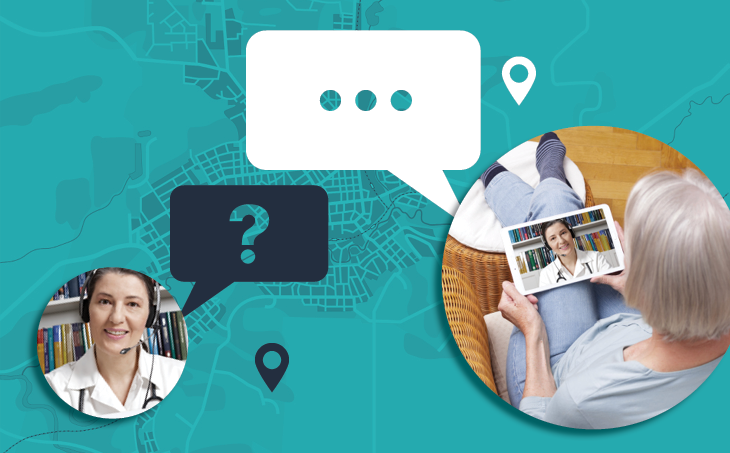Three guiding principles for 2023 and beyond
Responding to consumers’ rapidly evolving expectations can seem like a moving target. Amazon continues to develop its shipping and returns strategy because their customers demand it. Meanwhile, Netflix is losing ground to streaming platforms that are responding more effectively to the viewing public’s content preferences. And let’s not forget Uber. They started by delivering people. Then they began delivering food. More recently, they have expanded to delivering almost anything—their ads will remind you—that isn’t even edible.
The same sort of thing is happening in healthcare, albeit much more slowly and without much of a plan for sustainability. Even this far into the pandemic, many providers are still relying on whatever two-way video technology solution they chose two years ago to get them through this “rough patch” until things returned to “normal.”
But in many ways, there’s no going back—at least not from the patients’ perspective. That’s why I believe we’re now reaching a tipping point where patients have the upper hand when it comes to seeking and receiving healthcare.
Three guiding principles
To ensure they stay ahead of the curve, I’ve spent much of my 18-year career helping hospital systems and large healthcare organizations preserve and expand their market share through strategic initiatives that minimize leakage, maximize operational efficiency, and improve the patient experience. And as we emerge from the pandemic (I promise, I’m not jinxing it by saying so), I’ve found myself recommending three important principles to healthcare strategists, operations professionals, and technology experts.
1. Follow the trends
Even as far back as 2015, my colleagues at eVisit observed a shift in patient expectations fueled by technology’s inexorable march toward consumer convenience. Fast forward to 2022 where today’s patients take virtual care for granted. Whenever possible, patients are increasingly gravitating toward technology-enabled care encounters. Consider that:
- A recent study found 35% of people would consider replacing their primary care providers with qualified physicians on demand via telehealth.
- Over 45% of hospital executives say they lose patients to competitors who offer easier access to care.
- More than half of Millennials and Gen Zers would consider switching to more convenient virtual care delivery models.

Trends toward convenience and consumer experience are commonplace in nearly every industry, so it’s no surprise we’re seeing them establish themselves in healthcare. To stay competitive, providers must respond to patients’ expectations for a modern consumer experience. Just like Amazon. Just like Uber. Just like Netflix… except, well, you know.
2. Embrace hybrid care delivery
I’d wager that most readers of the Virtual Care Blog share a common purpose—to help patients achieve their personal health goals. As with many industries, however, the pathways toward those goals are a mix of science and art, technology and relationships, convenience and trust.
It’s all about finding the most effective blend of what works for your consumer based on their situation. This is why I believe the future of care delivery is a hybrid model that leverages the best attributes of in-person care and telemedicine to ensure patients are getting the right care in the right place at the right time with the right provider or care team.
Take patients with chronic conditions, for example. With the right digital front door in place, today’s advanced care delivery platforms may recommend the patient’s first visit be in-person with a physician. After this initial visit, care can be delivered through a variety of modalities, including two-way video, asynchronous (SMS or text-based) messaging, and live chat based on provider availability and patient preferences.
While the reimbursement rates for some types of encounters may be lower than in-person visits, the ability to see more patients per day, higher incentives for value-based care, and the enhanced patient-provider relationship that results from more frequent and regular touchpoints cannot be underestimated in terms of sustainable revenue.
3. Maximize technology integrationsWell before the pandemic, healthcare operations professionals knew the importance of being able to triage patients quickly and accurately. It was common sense—dollars and cents—that the more patients your practice could see in a day, the better your revenue stream, not to mention higher patient satisfaction rates through shorter wait times and accelerated pathways toward the right care.
Today, the right care delivery platform can help determine whether a patient’s first visit can be virtual, or if they need to be seen in person. This frees up your queue of patients waiting for appointments. With a symptom checker integrated directly in the platform, the patient can be correctly triaged toward whichever type of visit is most appropriate.
Even more efficiencies are achieved when the platform plays nicely with your electronic health record (EHR) software. When details such as patient history are at the provider’s fingertips, both care teams and the patient experience significant time savings. The same goes for integrated workflows where the EHR is leveraged within the care delivery platform to record vitals and assign billing codes.
Next steps
At eVisit, we believe one size doesn’t fit all. Schedule a consultation to tell us about your unique challenges with care delivery.






